

|
| weblog/wEssays archives | home | |
|
Inflation/Deflation V: Bonds and the Dollar (January 12, 2007) Before we get to this chart, let's re-cap the week's entries. 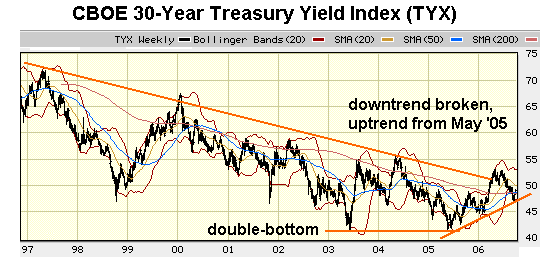
Monday, I suggested that Japan might not be a model for the U.S., as Japan's domestic savings have enabled staggering federal deficits. In nations without savings (the U.S. savings rate has been negative for years), such debt requires enormous capital inflows. To attract that capital and support the currency, interest rates have to be globally competitive. Japan's bond yields of 1% are not competitive. The U.S. does not have the luxury of 1% bond yields. It has dug itself a debt and a dependency on foreign capital which precludes uncompetitive yields. Tuesday, I covered how and what you measure will define whether you get the "answer" you seek on deflation/inflation. Statistics could indicate price deflation even as real-world families find prices for essentials are rising as prices for non-essentials are dropping. Measurements of CPI are based on prices of discretionary items, not just on what you have to buy to live. If you no longer make discretionary purchases, then the advertised "deflation" has no meaning. Various absurd distortions in the weighting of housing and healthcare render such measurements utterly unreliable. Wednesday, I pointed out that the "low hanging fruit" of deflationary pricing from China has all been picked; Chinese producers are squeaking by on razor-thin margins. If prices drop from here, they will be driven out of business by losses. Losses eliminate competition which then eases deflationary pressures regardless of money supply expansion or contraction. The real world measures deflation-inflation in prices moved by supply and demand; monopoly capital sets prices to remain profitable. Asset deflation can continue for a long time, but consumer pricing deflation soon reaches an end point. Thursday, I posted charts which showed gold has outperformed all major stock indices since 2002, and suggested that gold, as a hedge against either inflation or economic uncertainties, did not seem to be predicting a deflationary environment--unless that means a global flight from all paper assets in all nations. Today we look at U.S. Treasury bonds--which means we also look at the dollar. The deflationary camp generally holds that Treasuries will prove to be a wonderful asset to own, as yields (interest rates) will decline a la Japan circa 1990-2006. As yields drop, the value of current bonds rises in proportion. A bond yielding 6% will roughly double should yields drop to 3%. But history suggests yields will rise for another 15 years--rendering Treasuries an asset which will be in massive decline for years to come. 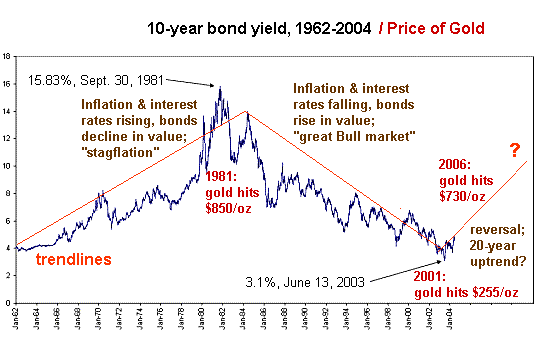
This chart suggests bonds operate on cycles of about 20 years. The cycle of declining yields (1982 - 2003) is over. The cycle of rising yields has begun. I again want to suggest that deciding "this will happen because I believe XYZ" is unlikely to succeed as an investment strategy. These charts are rather unambiguous, and so the question becomes, what might cause interest rates and yields to rise for the next 15 years? One possible answer is a defense of the dollar. The U.S. has a vested interest in conflicting forces: a dollar which weakens against other currencies will work to reduce the stupendous trade deficit, but a collapsing dollar will remove the "safety" which supposedly motivates foreigners to buy trillions of Treasury bonds (which are of course priced in dollars.) A dollar which drops 50% will also drop the value of bonds held by foreigners by 50%--a loss few are willing to suffer. Here we see a dollar which has weakened considerably even as bond yields bottomed and rose. 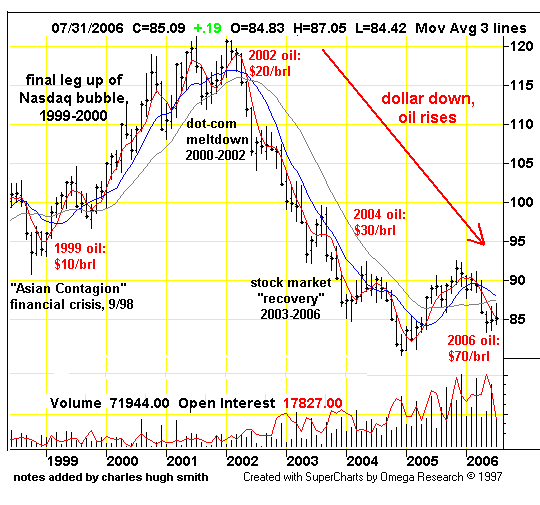
Is it coincidence that gold started outperforming the global stock market shortly after the dollar began its slide? Here is where we see the key difference between Japan and the U.S. The U.S. must defend its currency, as it depends on non-U.S. buyers of its Treasury bonds to fund its trillion-dollar deficits and public debt. Japan did not need to defend its currency, nor tempt foreign buyers to buy trillions of its public debt. This is why I consider the deflation-inflation debate of little value. The U.S. Treasury has to sell $400 billion of new bonds to fund the Federal deficit and another trillion or so of old debt which comes up for renewal every year (Recall they stopped selling the 30-year bond for a few years.) And this is before the Baby Boom retires and the recession of 2007-2012 slashes tax receipts; deficits might rise to unforeseen levels in just a few years, putting even further pressure on the Treasury to sell more bonds on the global marketplace. Whether money supply increases or decreases, whether asset prices deflate or inflate, whether the cost of sneakers declines or rises, the bonds have to be sold. There is no Plan B. Please note the first two charts were of bond yields. As yields rise, the value of existing bonds plummets. As yields fall, the value of existing bonds rise. Here is a chart of U.S. bond values. Note that it dropped to its low when yields topped out in 1981. (Chart courtesy of Harun I.) 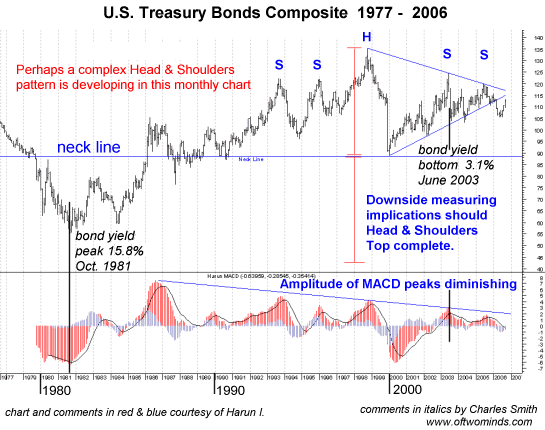
If the wedge formation breaks to the downside (which history suggests it will), the downside target is even lower than the nadir reached in 1981. That would suggest yields might rise even higher than the 16% top hit in 1981. What could cause such an unexpected rise in yields? Let's start with that supposed impossibility, inflation: 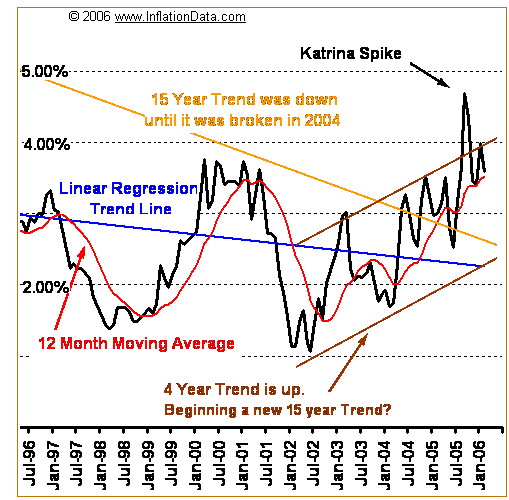
As I have posted before, I see evidence that key non-discretionary sectors--energy and food--could be beset with sharp increases in price due to huge supply-demand imbalances. With supermassive oil fields in Kuwait and Saudi Arabia already in decline, with the mideast looking more like Europe 1914 every day, with China's food supply in decline even as demand soars, as global warming shifts weather patterns into extremes of drought and flood--it takes little imagination to foresee oil rising above $100/barrel and grains increasing in price five-fold or even ten-fold. Copper can tank and steel can plummet, but when push comes to shove, you don't need to buy a new house full of copper wiring or a new car of steel and plastic. But you do need to eat and consume energy--and pay your mortgage and credit card debt. The standard deflationary line is that the world is awash in borrowed cash seeking returns, and there is no better place to park all that money than U.S. Treasuries. In other words, yields will drop because the demand for Treasuries will only rise as times get tough. Let me propose a somewhat different scenario. Let's say an "unexpected" (at least by the usual cheerleaders and media outlets) financial disruption occurs which causes some of the trillions in derivatives to go sour, causing massive selling of the underlying assets to raise cash to reduce margin and other debt. Such a sudden "crisis" could erase trillions from global liquidity. How? Because the money was lost. The derivatives turned out to be worthless, and the stocks and bonds were sold into a plummeting, panicky market. In this scenario, Treasuries would be sold along with every other paper asset in a desperate bid to raise cash to pay off an avalanche of debt being called. (Recall that if you bought a derivative to "protect" your portfolio, and the company on the other end of that derivative folds, you get nada. Meanwhile, the derivative you sold kicks in and you owe someone else billions in "insurance" which you must raise the hard way, by selling assets regardless of how low they've dropped.) So exactly where did the global liquidity go? It vanished in losses. Where did demand for Treasuries go? It vanished, too. As the panic deepens, feeding upon itself as such financial panics tend to do (based as they are on human emotions), then the Treasury auction comes up as usual, every few weeks. Hmm, no buyers at 4.5%. Let's try 6%. Yikes, no buyers; people are still selling hundreds of billions of bonds, not buying. Let's try 10%. OK, a few takers, but we gotta move $500 billion in bonds by tomorrow. How about 12%? You see where this goes. If yields double from 4% to 8%, every existing bond just lost half its value. Now you're getting 50 cents on the dollar for that "safe" Treasury bond, and you decide to sell now before it goes to 25 cents. Alas, so does everyone else. The Treasury has no choice but to jack yields up to whatever it tales to induce panicky buyers to risk cash on a Treasury which could drop the next day or the next week. That's how yields could get back to 16%, and in a hurry. That's how the bond market could be gutted, and trillions in wealth destroyed. Inflation "can't happen." Yields "have to drop." Really? Given the charts above, that sounds more like a religious belief than analysis. If you believe such a crisis is unlikely, please read Benoit Mandlebrot's The Misbehavior of Markets For more on this subject and a wide array of other topics, please visit my weblog. copyright © 2007 Charles Hugh Smith. All rights reserved in all media. I would be honored if you linked this wEssay to your site, or printed a copy for your own use. |
||
| weblog/wEssays | home |